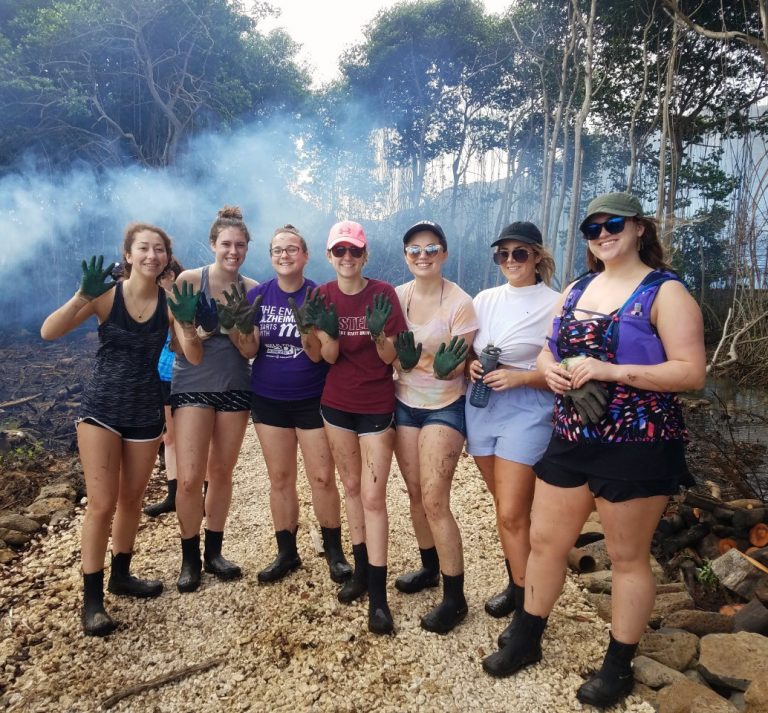- Apply
- Visit
- Request Info
- Give
Revelations Abound in Hawaii for Eastern Students
Written by Michael Rouleau
Published on January 17, 2019

Twenty psychology students expanded their worldview over winter session during a global field course in Hawaii. Titled “Cross-Cultural Well-Being and Relationships in Hawaii,” the course ran from Jan. 2–11. Students were immersed in the local culture and visited some of the island chain’s most breathtaking sites.
“This course was designed to provide an overview of cross-cultural issues related to well-being and relationships,” said Psychology Professor Madeleine Fugère, who led the trip with Professor Kristalyn Salters-Pedneault. “Aspects of well-being and relationships were examined from Western and native-Hawaiian perspectives.”
The Eastern students examined differences in attachment styles, social support, parenting, psychological disorders, personality and emotional expression, physical attraction, romantic relationships and compassionate love.
“I came to realize some of my own cultural biases,” said Danielle Gallagher ’20. “Being aware of these biases will enable me to interact better with individuals from a multitude of cultural backgrounds, which will not only help me in achieving my career goals, but in my daily interactions in general.”

One of the students’ most impactful realizations was how the native people relate interpersonally. “Hawaiians have a strong sense of family and community,” said Erica Mchugh ’19. “They call everyone cousin, uncle and other familial terms. Throughout our trip, many of the locals referred to us as cousins, even though we had never met them before.
“Hawaiians put a lot of emphasis on the ‘aloha spirit’ and treating everyone with kindness,” added Mchugh. “We’re not used to this concept in the Northeast. Most of the time we don’t think to stop and say hi to a stranger.”

What struck Brianna Starkey ’19 was how the natives regard members of the LGBTQ community. “Native Hawaiians have a much more accepting approach to individuals in this community, especially transgender individuals,” she said. “We learned that individuals who identify with both masculine and feminine genders are called ‘mahu,’ which means having the spirit of a male and female. These people are not judged as having something wrong with them like they often are in our culture.”
Another revelation was the people’s connection to the land, and their respect for volcanic activity. “We spent so much time in nature — restoring an ancient fish pond, exploring lava tubes, hiking the ancient petroglyph trail — it was impossible to ignore the respect for the land all around us,” said Gallagher, who remarked on the prevalence of signs reminding nature goers to be respectful of wildlife, as well as the cultural emphasis to live more sustainably.
“‘Pele’ is the goddess of the volcanoes, who is credited with creating the islands,” said Gallagher. “There is a lot of respect for Pele and her land because Hawaiians feel it is a gift that they are able to be there. There is no sense of entitlement or ownership over the land, but gratitude and respect toward it.”

During a tour in which the Eastern group saw a road covered in hardened lava from the volcanic eruptions of summer 2018, the guide informed them that Hawaiians don’t divert the lava’s path, out of respect for Pele.
“This mindset was incredibly hard for me to relate to because there is a strong sense of land ownership in our culture and it’s rare to see such passivity in relation to natural events,” added Gallagher. “Our culture attempts to exert control over events as much as possible, rather than accepting and embracing them as they come.”
Another highlight of the trip was a volunteer project at the 800-year-old Pae Pae fishpond, which is a source of food for the locals but currently damaged by storms and the growth of invasive plant species.
The Eastern group also went on several excursions to sites such as Pearl Harbor, Puako Petroglyph Field, Rainbow Falls, Imiloa Astronomy Center, Volcanoes National Park, Punalu’u Black Sand Beach, Pu’uhonoa o Honaunau National Historic Park, and St. Benedict’s Catholic Church (Painted Church).


